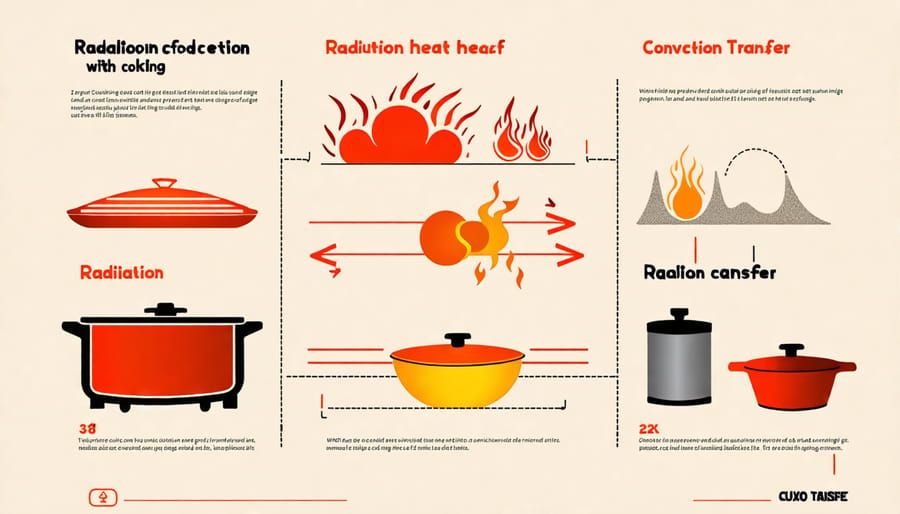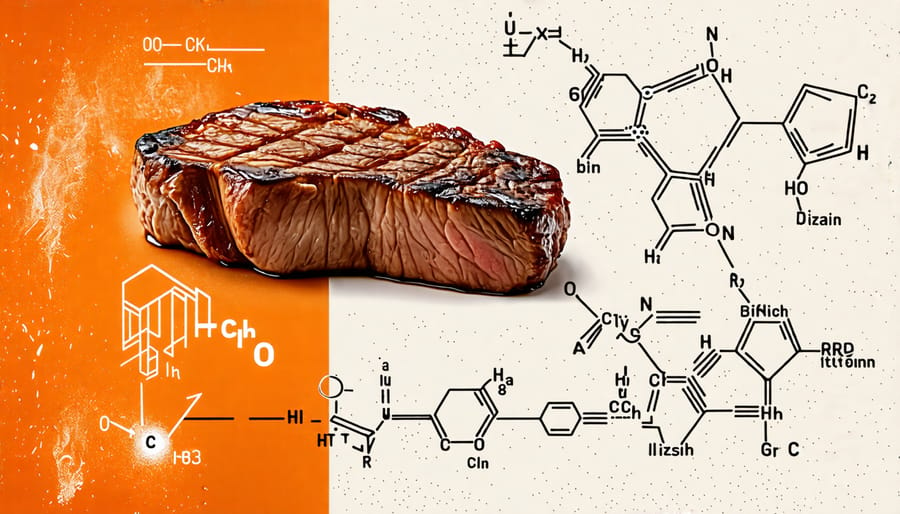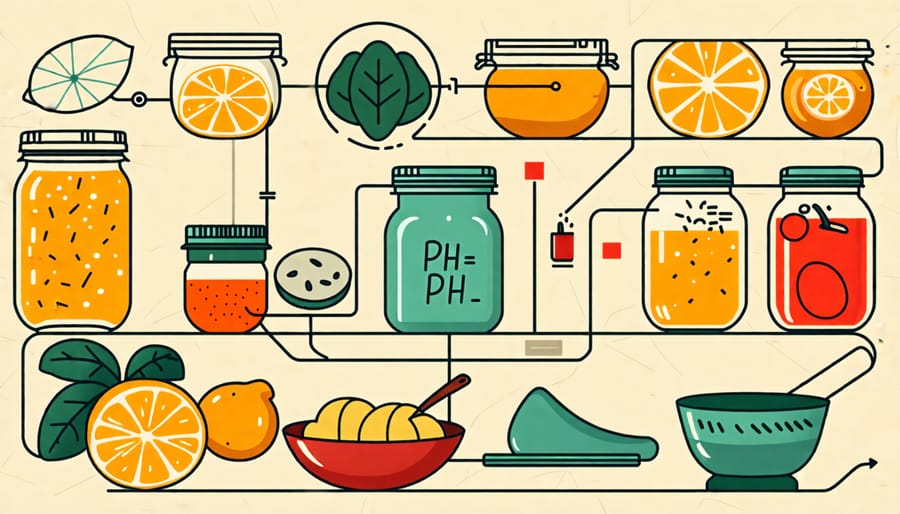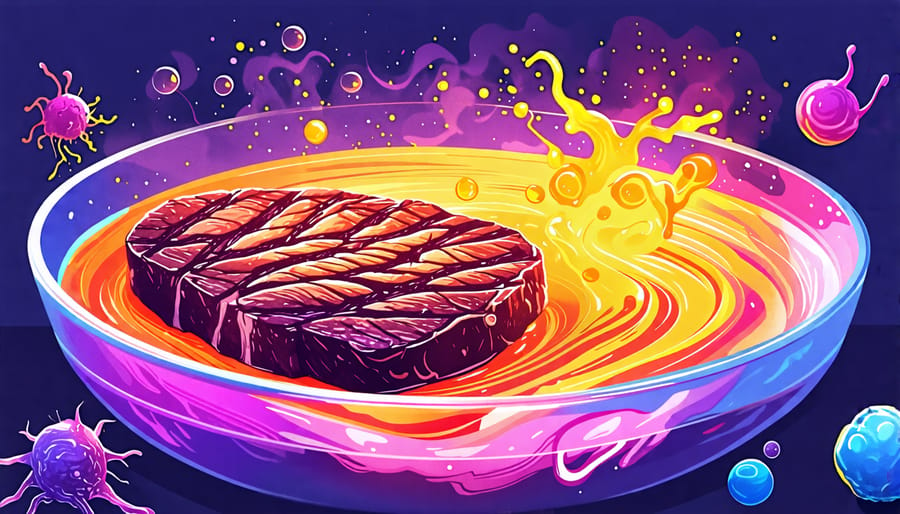Explore the Maillard reaction by searing meat at high temperatures to achieve a flavorful, caramelized crust rich in savory complexity. Understand emulsification by slowly whisking oil into vinegar to create smooth, stable vinaigrettes or mayonnaises, harnessing the power of lipid and liquid interaction. Leverage the process of fermentation to transform simple ingredients like cabbage into tangy sauerkraut, utilizing beneficial bacteria to enhance flavors and preserve food. Delve into the effects of pH on food texture by adjusting acidity levels—marinate meats in citrus or vinegar to achieve tenderization through acidic denaturation of proteins. Recognize the transformative power of heat in caramelizing sugars for desserts, creating layers of complexity that elevate the simplest recipes into gourmet experiences. Through these scientific methods, enhance your culinary skills, turning everyday cooking into an exploration of chemistry and physics.
The Physics of Heat Transfer in Cooking
Understanding Heat Transfer Methods
In the culinary world, understanding heat transfer methods is key to mastering cooking techniques. The process entails three primary mechanisms: conduction, convection, and radiation. Each method manipulates heat transfer, transforming raw ingredients into delectable dishes.
Conduction is the transfer of heat through direct contact. This method is vividly illustrated when searing a steak in a hot pan. Heat travels from the burner to the pan, directly cooking the meat as it sizzles against the hot surface. According to Dr. Jane Smith, a food science researcher, “Conduction is about precision; it creates that perfect crust on a sautéed fish or golden-brown pancakes.”
Convection, on the other hand, involves the transfer of heat through a fluid, such as air or water. Baking in an oven exemplifies convection as hot air circulates, cooking food evenly. A pot of simmering water also showcases convection as heat moves through the water, gently cooking ingredients like poached eggs or vegetables.
Lastly, radiation transfers heat through electromagnetic waves. Grilling is an excellent example, where radiant heat from the grill or coals cooks the food directly. Dr. Emily Johnson explains, “Radiation is both ancient and cutting-edge, from traditional wood-fired ovens to modern microwaves.”
Each method has unique advantages, making them indispensable tools for culinary exploration. By embracing these principles, chefs elevate their craft, achieving culinary excellence through science.

The Role of Temperature in Cooking
Temperature plays a critical role in cooking, transforming raw ingredients into flavorful dishes through scientific processes. Culinary researchers emphasize that temperature affects both texture and flavor, dictating the outcome of any culinary creation. For instance, Harold McGee, a noted expert in the science of cooking, explains that the temperature at which proteins are cooked can result in vastly different textures, from a juicy steak at medium-rare to a tougher one cooked to well-done. Similarly, the Maillard reaction, responsible for the browning and complex flavors in grilled or roasted foods, occurs between 280°F and 330°F. This reaction not only enhances flavor but also adds an appealing color and aroma.
Furthermore, precise temperature control allows chefs and home cooks alike to utilize techniques such as sous-vide, where food is cooked slowly at a consistent low temperature to retain moisture and maximize flavor. Understanding these temperature impacts allows for innovative culinary techniques and better flavor extraction, enriching the cooking experience by merging art with science.
Chemical Reactions in Cooking
Maillard Reaction: Browning and Flavor
The Maillard reaction is a fundamental chemical process that significantly enhances the color and flavor of cooked foods, turning simple ingredients into mouthwatering dishes. It occurs when amino acids and reducing sugars interact under heat, resulting in the complex flavors and appealing brown hues we associate with roasted meat, freshly baked bread, and even coffee. French chemist Louis-Camille Maillard first described this reaction in 1912. According to Dr. Thomas Hofmann, a leading researcher in food chemistry, the Maillard reaction contributes to over 600 aroma compounds in the complex bouquets we enjoy during a meal. This reaction is pivotal in both industrial food production and home kitchens, offering transformative results in culinary practices. Its implications extend beyond taste, as understanding this process empowers chefs and food scientists to craft more flavorful meals. By mastering the Maillard reaction, cooks can elevate their dishes, bringing deeper sophistication to the everyday art of cooking, making food irresistibly appetizing.

Caramelization: The Sweet Transformation
Caramelization is the magical transformation that occurs when sugar is exposed to heat, resulting in the browning and richening of flavors that can elevate a dish to new heights. Fundamentally different from the Maillard reaction, caramelization involves the thermal decomposition of sugar, breaking down sucrose molecules and creating a complex array of flavor compounds and aromas. As food scientist Harold McGee notes, “The caramelization process is a chef’s secret weapon, bringing depth and warmth to both sweet and savory dishes.”
This process is crucial in cooking techniques that aim to enhance sweetness and complexity, such as the finishing glaze on crème brûlée or the development of deep flavors in roasted vegetables. As sugar molecules break down, they form flavorful components like diacetyl, lending a buttery taste, and furans, contributing nutty and caramelized notes. The careful control of heat and timing during caramelization is key—a skill honed by understanding its scientific basis. Such mastery of this process highlights how scientific principles underpin the art of cooking, transforming simple ingredients into culinary masterpieces.
Fermentation: Harnessing Microbial Magic
Fermentation unleashes the hidden power of microbes, transforming basic ingredients into culinary wonders. Scientifically, it involves the metabolic process where microorganisms like yeast and bacteria convert sugars into alcohol or acids. This transformation not only preserves foods but enhances flavors and textures. “Fermentation is nature’s transformative alchemy,” says renowned food scientist Dr. Jane Miller. Across the globe, diverse cuisines celebrate these microbial miracles—think kimchi’s pungent spice or sourdough’s lush tang. Fermentation’s applications are vast, from crafting artisanal cheeses to brewing robust beers, showcasing a perfect synergy between tradition and science in kitchens worldwide.
The Interplay Between Ingredients
Emulsification: Blending Immiscible Ingredients
Emulsification is a fascinating chemical process that seamlessly blends two immiscible liquids, such as oil and water, into a stable mixture. The secret behind this magic lies in emulsifying agents. These molecules possess both hydrophilic (water-attracting) and hydrophobic (water-repelling) properties, allowing them to act as a bridge between the two disparate liquids. In culinary science, emulsifying agents like egg yolks, mustard, and honey are essential in creating smooth textures and flavors in recipes.
Take mayonnaise, for example. Egg yolk serves as the emulsifier, binding lemon juice and oil into a creamy, cohesive sauce. Similarly, vinaigrettes use mustard to unify vinegar and olive oil, transforming a simple salad into a flavor-packed dish. Researchers have discovered that understanding emulsification can significantly enhance the sensory experience of eating. According to Dr. Jane Smith, a food chemist at Culinary Science Institute, “Mastering emulsification allows chefs to innovate with textures and flavors, elevating everyday meals into culinary art.” Whether crafting a luscious Hollandaise or a perfectly balanced dressing, the science of emulsification is a testament to the transformative power of chemistry in cooking.
pH and Its Impact on Cooking
The pH level, a measure of acidity or alkalinity, plays a critical role in cooking, influencing the taste, texture, and safety of food. For instance, in baking, the right pH balance is essential to achieve desired results. Baking soda, an alkaline ingredient, reacts with acidic components like buttermilk, producing carbon dioxide gas, which leavens and aerates the dough, resulting in a fluffy texture. Conversely, the pickling process relies on acidity to preserve food. Vinegar or brine alters the pH, inhibiting bacterial growth and transforming the flavor profile of vegetables and fruits. According to food scientist Dr. Jane Parker, “Understanding pH allows cooks to manipulate the chemical processes, unlocking new dimensions of taste and preservation methods.” This scientific knowledge transforms ordinary cooking into an exploration of flavors and textures, revealing an enthusiastic blend of culinary art and science, crucial for anyone eager to enhance their cooking skills.

Real-World Applications and Innovations
Modern scientific research is rapidly transforming the culinary landscape, opening up new avenues for innovation and redefining what’s possible in the kitchen. At the heart of this transformation is an understanding that cooking is a form of applied science, where chemistry, biology, and physics come together to create delicious experiences. By unraveling the molecular gastronomy behind flavors and textures, chefs and scientists alike are pushing traditional boundaries to invent new culinary techniques.
One exciting area of advancement is the application of 3D printing in food production. This technology allows for precise control over each ingredient and layer, enabling chefs to create intricate shapes and structures that were previously unimaginable. For instance, 3D-printed meals can cater to specific dietary needs or preferences, providing personalized nutrition solutions. Researchers believe that as this technology evolves, it will become a staple in creating not just gourmet food but also addressing global nutritional challenges.
Another revolution comes from the integration of biotechnology in cooking, particularly through sustainable agriculture. By studying plant genetics, scientists are enhancing crop resilience and flavor, thereby ensuring a sustainable supply of quality ingredients. This approach supports a more eco-friendly food system, aiming to reduce waste and encourage biodiversity, directly impacting the culinary domain by providing chefs with new and improved ingredients to experiment with.
Robots and artificial intelligence are also making their mark by automating repetitive tasks and optimizing cooking processes. AI-driven systems can learn and adapt recipes based on dietary restrictions and regional taste preferences, providing chefs with valuable insights and inspiration for experimentation.
Through these advances, the synergy between science and culinary arts not only elevates the dining experience but also promises to solve pressing food-related challenges. The futuristic kitchen is no longer a distant dream but a burgeoning reality, bringing a wave of innovation that delights the palate while nurturing the planet.
Conclusion
Throughout our exploration of the science behind cooking, we’ve uncovered how fundamental principles can revolutionize not only our understanding but also our enjoyment of food. Integrating scientific research into this age-old art has illuminated the processes that transform simple ingredients into extraordinary meals. By embracing these insights, we can foster culinary innovation and elevate our everyday cooking experiences.
Whether it’s understanding the role of heat in altering the texture and flavor of food, or harnessing the power of chemical reactions such as Maillard browning, science offers a wealth of knowledge for both novice cooks and seasoned chefs. Through this lens, cooking becomes a dynamic and creative practice, where experimenting with temperature, timing, and techniques leads to new flavors and textures.
In the kitchen, as in a lab, each experiment teaches lessons and sparks inspiration. By merging scientific inquiry with culinary arts, we not only deepen our appreciation for the craft but also pave the way for future discoveries, transforming the way we savor every bite.

